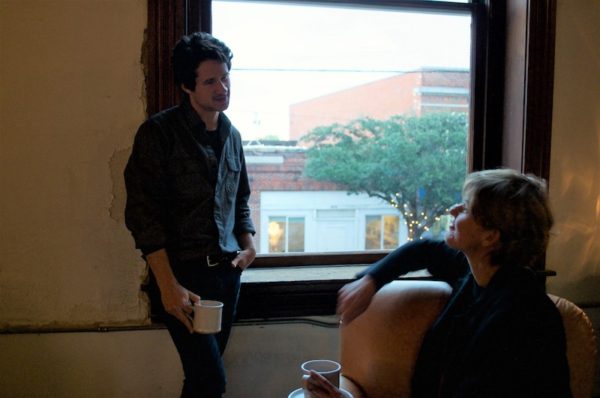
Kyle Hobratschk and Adrienne Lichliter talk about the founding of the residency in the second story common area. Photo credit: Tatiana Ryckman.
At the end of my two-week residency at 100W in Corsicana, Texas, I sat down with Kyle Hobratschk and Adrienne Lichliter to talk about their experience of founding and running an artist and writer’s residency in small-town America. As we talked in my writer’s studio, they provided insights into the nuts and bolts of the operation — from lessons learned, to the delicate balance of social design and funding.
Tatiana Ryckman: What are your roles in the residency?
Kyle Hobratschk: I’m director and co-founder, alongside Travis LaMothe. Travis and I work together on most every decision, from aesthetic approach, residency accommodation, and programming. The building is a blend of our separate studio and domestic practices, from work table construction to wool blanket selection. And it’s taken the commitment from several close friends to get this place and program off the ground, like Adrienne, Nancy Rebal and David Searcy, Randell Morgan, Kiernan Lofland and Anna Membrino.
Adrienne Lichliter: I’m the Events Coordinator, but I’m thinking about a title change.
KH: (laughs) Oh yeah?
AL: Basically [I do] programs and events. I cook the dinners. I’m a brain-stormer.

The third floor studio was the performance hall of the building’s original owners, the Odd Fellows, shown here with the work of former resident Bradley Kerl. Photo credit: Kyle Hobratschk.
KH: I’m thankful for Adrienne to be a part of this project. She has a calmness in engaging community in a way I’m not always disposed to when chasing loose ends. She has an effortless elegance about carrying on these communal moments. And she makes this place hers.
AL: When I came and made a pizza dinner a couple nights ago, I thought it’s so funny how fast the residents become like kids at a summer camp. They’re fast friends. It just takes someone to bring it in for a group hug.
KH: We’ve also been fortunate with the residents coming through. They’re all nice people dedicated to their practice. We’re finding that successful residencies with successful communities, it’s a lot of work. A lot of programming. We’ve talked about maybe having a weekly time that residents go from studio to studio and talk about the work.
AL: But it’s a balance, you don’t want it to feel forced.
(Author’s note: I was originally skeptical of the temporary wall that separated my room from the hallway. It was tall and sturdy, but also deliberately moveable and seemed to imply a sort of fluidity of space that made me uneasy. Very quickly, though, I found that this allowed for a valuable cross-pollination between artists. The industriousness of other residents, or congeniality between them, traveled freely from room to room. “Forced” is not a word that comes to mind.)
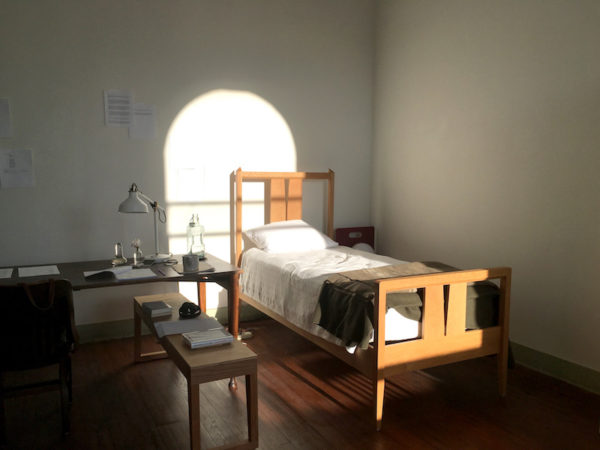
The 100W residency has been described as “monastic.” This description can be seen in the simple writer’s studio. Photo credit: Kyle Hobratschk.
AL: There’s a quality to this building — when I walk in, I have this combination of ease and excitement. I think that that’s something you want to share with people because it’s a good feeling. I don’t want to make it sound like a magic spell, but that’s how it feels when you walk in the door. And even when I’m not here, just knowing it’s there. Maybe it’s the separation from my life in Dallas, but I think that simplifies it too much, so I like the magic comparison.
KH: I didn’t buy the building with the intention of making it a residency. I was looking for a wood shop in Dallas… . I just threw around the idea of finding a space where some friends and I could pool resources. Nancy Rebal attended a printmaking workshop I was leading, and she suggested that I come look at one of her friends’ available properties here in Corsicana. I came to look at the building and it felt very forgotten; windows were knocked out, it was moist, there were a lot of leaks. But I just loved this building. Something about these particular rooms.
After a few years we found the building wasn’t maximizing its potential usage with people who had long-term commitments in Dallas. It took other people mentioning to me that a residency was a thing or a possibility. I realized it made more sense for people to come for shorter concentrated periods of time — from father away, and leave their life — than it did for people to come from Dallas, 50 miles away, and try to make a go of it for a couple of years part-time. So the concept of a rotation, or a residency was appealing. And then it became fun. Because then we got to give [the building] an identity. [Now] people come and you share it with them and you see what they do here.
AL: Kyle and I are looking at when different [residents] are coming, and deciding Do these three artists make sense for a dinner? Or some other event?
KH: We’re getting to know their work before they show up so we can plan tailored events toward their work. Not just an open studio.
I’m looking forward to that day when we have on our coffee table — we don’t even have a coffee table right now — a hard-bound catalog, published with a collection of the writings and visual works that have come out of this building over the last several years… as a feature that tries to encompass all the workings in this building so that people can experience it in places outside of this building. I think this is a pretty special, intimate place that may feel closed to just a select number of folks who get to come through. I think we have a rich story, and I want to be reassured that we‘re taking steps to document and share it.
This is a very patient place. Adrienne has said that before, and I think that’s a great word. And producing something on that scale is a patient project.
AL: So it’s not just on our Instagram accounts.
KH: The seasons go by so fast, we have these great residents that come through, we get to know them and then they leave and it’s on to the next. Next, next, next. Don’t you want to have it? So it won’t just fly away?
(Author’s note: In the studio next door, artist residents Alisha Croft and Marguerite Lloyd have lined all the windows with pink cellophane. On our last day at the residency we built an all-white shrine that glowed in the strange light. These are precisely the works and moments that I understand Kyle wanting to document, because the next day all the cellophane came down, we all pointed our cars in the direction of home, and things returned to normal.)
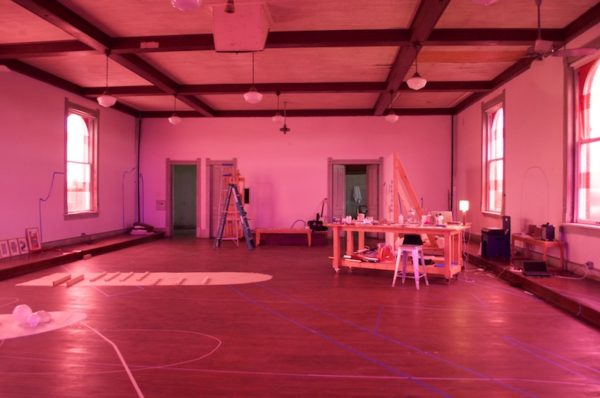
During their stay, artist residents Alisha Croft and Marguerite Lloyd covered the many windows in their third floor studio with pink cellophane, casting the room in a strange pink glow. Photo Credit: Tatiana Ryckman.
KH: The greatest benefit [of running the residency] is getting to know the people. We have residents who want to come back and if we’re here to support their practice, then it makes sense for them to come back. They’re going to get a lot done.
AL: I think of the resident artist, Ed Eva, who said with his British accent: “I’ll always know that there’s a little town in Texas where I can buy a house.”
(Author’s note: I too have thought of buying a house in Corsicana. I’ve ridden around with Nancy Rebal, looking at real estate. It’s hard to say if it’s Corsicana, or 100W, or Nancy that compels people to try to find a way to stay, or to hold onto the idea of the place just for reassurance that it’s there.)
AL: It’s not just about giving artists time and space generally, it’s about this time and this space. There’s a sense of simplicity. To have a whole day where you’re just making work in an isolated space you find your best habits.
KH: Maybe in offering something in the way the space is laid out, or [with] a system of practices, or lifestyle, [I hope residents] adopt something and take it back with them. Just a way of being. Maybe we try to culture some ways of being here that people test out for a month, and they go home and re-evaluate their domestic space and think ‘Huh, I was a month away without doing or having these certain things,’ and cleaning up clutter in their life.
(Author’s note: Clearing away clutter is something that happens mentally as well. I found myself drifting far field while a resident. After a few days, I stopped writing altogether. For the first time in years I let myself engage with process over product, and I heard this echoed by the other residents. We made things unlike anything we’d made before. I spent the next week and a half painting gifs and weaving and building things for the sake of doing it. It’s a way of being I’ve brought back with me to my “real life” and am looking forward to reintegrating into my writing practice.)
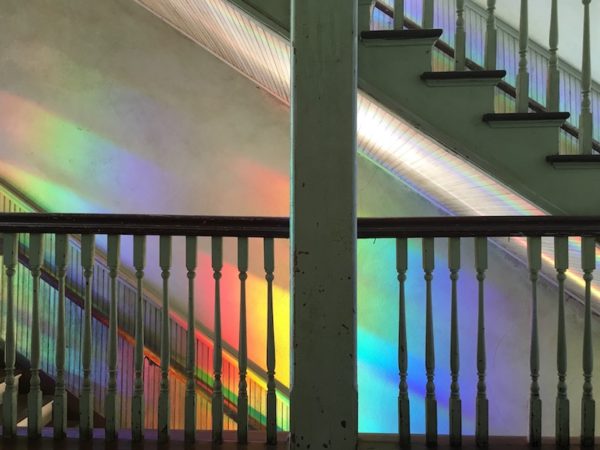
Much of the building has been restored to its original state, with subtle additions like this rainbow installation on the stairwell by Randell Morgan. Photo credit: Kyle Hobratschk.
KH: I also hope the artists maintain their relationships with other residents. I’m not monitoring to know, but I hope there are emails happening right now between residents that became close. And for people who aren’t from Texas, that there’s a reconsideration for what it is to be from Texas or a small town. I have realigned my viewpoints in how things can generate and take place. And maybe five years ago I would have thought urban centers were the thing. But now I think small town America is the best thing we have. There’s low barrier to entry. This place shows that things are possible.
I was a naïve twit when I showed up… . I had no idea how amazing the people who live here are, and how important they are to sustaining the residency.
AL: It’s been fun to see how it’s become a point of pride for the town.
(Author’s note: Just a few nights before this conversation took place, the local florist had invited the residents up for drinks in his other-worldly apartment, and shortly after our interview ended, Nancy guided the artists down the street to the town jail, which has been converted into a lovely private residence. Each local repeated the same sentiment: a desire for the arts community to grow in their town.)
KH: I think there’s a responsibility with this program to make available these works to the town.
AL: There’s a humility about this building and this town that’s not associated with the arts. I would like 100W to placate this thing that plagues the arts — this hierarchy of thinking. That sounds archaic, but… we have people coming in from Dallas who are knowledgeable about art and art history and they’re used to looking at these things, but if we only think from their perspective, we’re going to alienate the town. The reality is having, on my end, programs that allow people to experience art in different ways. So [I’m] thinking about how I can make that point of entry. I’m dying to have a play here, that’s written for this building and performed here. A ballet. There’s so much possibility, and we’ve been wrapped up in just trying to make things flow.
When you ask about the future, we’re not even aware of what the possibilities will be with funding. Like with the dinners we have. You should see what we pull off on a tight budget. I think this building could raise some great money and find more ways to connect with the community. It’s on the horizon, so I’m excited to see what that would look like.
KH: This thing just tries to make expenses from the most reasonable possible residency rates. So we offer two fully-funded residencies to one artist and one writer. We really regret for someone not to come just because of rates, so we might trade for art work so we can build a collection. Or we try to find local opportunities to help them.
We have no funding other than a local nonprofit, the Navarro Council for the Arts, which provides $2,500 to 100W, which a review committee disperses in a few hundred dollar increments to those applicants who requested additional funding. They then share their work, likely with a high-school audience. Beyond that, it’s not a nonprofit so we don’t have funding coming in. We don’t have fundraisers. We don’t have that for a few reasons. One reason is time; I’m working on the building and not doing paperwork to file for that.
To our benefit, a lot of these programs may start with the nonprofit first and then establish the residency, and here we had a running start so we know what the mission statement is. We have something that has been successful and people investing in it will know what they’re investing in.
KH: We don’t have a hard and fast rubric [for selecting artists]. It’s not based on resumés or international relevance. We’re truly seeking those applicants who can make the best use of the space. The space, the region, the quiet. As we read through an applicant’s proposal we have a good intuition for what will be successful here.
AL: It’s not like 2018 is the year of minimalists or anything.
KH: We’re just looking for strong work and concepts. We’re just trying to bring the best here that we can, while also giving people who are nascent in their work a chance to work alongside people who have successful careers.
I’ve never been to a residency before. Maybe that’s what makes it what it is; there is no model. I’m not saying we’re doing anything new. But there’s a cluelessness to it that has worked to our advantage.
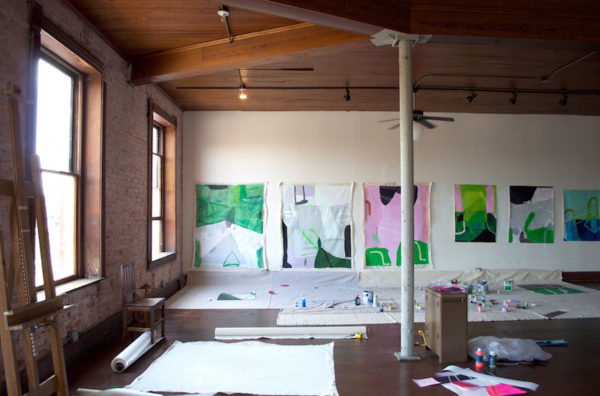
The studio pictured here occupies much of the second floor. The paintings are the work of resident Sarah Boyts Yoder. Photo credit: Kyle Hobratschk.
AL: Kind of like a reckless abandon. But a slow one. Kyle mentioned patience. The way things unfolded was at a pace that we could assess. We had time to think and as Kyle was building the building, there were people living here when things weren’t finished… . There have always been people involved in the space, and it arose organically.
It’s a lot of Kyle. He’ll never say this — he’s rolling his eyes — but when you get to know Kyle and you look at the building, his consideration is in the building. His aesthetic is in the building. His gentility.
KH: I’m just sort of a fastidious strange little kid.


